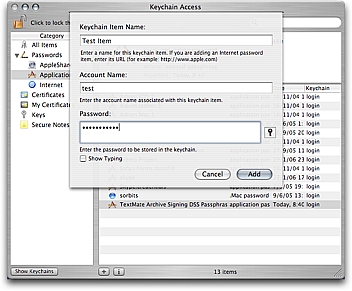
- #Mac keychain access how to#
- #Mac keychain access Patch#
- #Mac keychain access password#
- #Mac keychain access mac#
#Mac keychain access Patch#
In this way, Henze could trick the security service into piping the decrypted contents of the keychain into an application he controlled.Īpple's patch fixes the flaw and blocks the attack by preventing the security service from trusting manipulated sessions. It was possible, Henze discovered, to manipulate the session between Safari and the security service to make it seem like the session was initiated by the special, trusted keychain admin program that doesn't require user authentication. Basically, it's a reliably fruitful target for an attacker to hit, and other researchers have warned about keychain attacks in the past. The service can also store digital certificates used in web encryption and be used to manage public and private keys for encryption.
#Mac keychain access password#
Even if you don't use it as your primary password organizer, there's probably still sensitive stuff in there: The keychain is so seamlessly integrated into macOS that you may have saved some login credentials there without realizing it.
#Mac keychain access mac#
Now, having eventually changed his mind and revealed it to Apple, he is also showing exactly how it works at the Objective by the Sea Mac security conference in Monaco this weekend.Īpple's keychain is essentially a native macOS password manager. Initially, Henze refused to share details of his hack with Apple, telling media outlets that it was because the company does not have a bug bounty program for macOS. Apple patched the flaw that KeySteal was exploiting at the end of March. Dubbed KeySteal, the attack called attention to the fact that the macOS keychain makes a very attractive target for hackers.

"You know, the ones 'securely' stored so that no one can steal them :)" he wrote. Let config = MSALPublicClientApplicationConfig(clientId: "your-client-id",Ĭ early February, an 18-year-old German security researcher named Linus Henze demonstrated a macOS attack that would allow a malicious application to grab passwords from Apple's protected keychain. and only shared with other applications declaring the same access group Tokens will be saved into the "custom-group" access group MSALPublicClientApplicationConfig *config = *application = initWithConfiguration:config error:nil] If you'd like to use a different keychain access group, you can pass your custom group when creating MSALPublicClientApplicationConfig before creating MSALPublicClientApplication, like this: On macOS 10.15 onwards (macOS Catalina), MSAL uses keychain access group attribute to achieve silent SSO, similarly to iOS. However, it behaves similarly from a SSO perspective by ensuring that multiple applications distributed by the same Apple developer can have silent SSO. MSAL on macOS uses access group by default.ĭue to macOS keychain limitations, MSAL's access group doesn't directly translate to the keychain access group attribute (see kSecAttrAccessGroup) on macOS 10.14 and earlier. On iOS, add the keychain group to your app's entitlement in XCode under Project settings > Capabilities > Keychain sharing macOS This is the shared access group used by both MSAL and Azure AD Authentication Library (ADAL) SDKs and ensures the best single sign-on (SSO) experience between multiple apps from the same publisher. MSAL on iOS uses the access group by default.
#Mac keychain access how to#
This article covers how to configure app entitlements so that MSAL can write cached tokens to iOS and macOS keychain. For more information, see Apple's Keychain Items documentation.

SSO is achieved via the keychain access groups functionality. Caching tokens in the keychain allows MSAL to provide silent single sign-on (SSO) between multiple apps that are distributed by the same Apple developer. When the Microsoft Authentication Library for iOS and macOS (MSAL) signs in a user, or refreshes a token, it tries to cache tokens in the keychain.


 0 kommentar(er)
0 kommentar(er)
